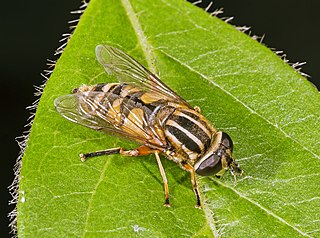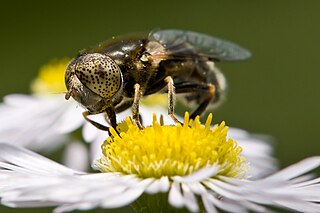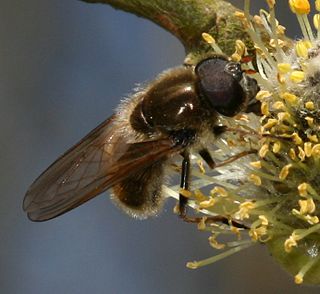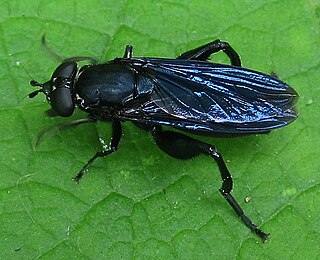Species
- S. aterrima Stackelberg, 1964 [1]
- S. claviventris (Strobl, 1909) [2]
| Syrphocheilosia | |
|---|---|
| Scientific classification | |
| Kingdom: | |
| Phylum: | |
| Class: | |
| Order: | |
| Family: | |
| Subfamily: | |
| Tribe: | |
| Genus: | Syrphocheilosia Stackelberg, 1864 |
Syrphocheilosia is a genus of hoverflies.

Hoverflies, also called flower flies or syrphids, make up the insect family Syrphidae. As their common name suggests, they are often seen hovering or nectaring at flowers; the adults of many species feed mainly on nectar and pollen, while the larvae (maggots) eat a wide range of foods. In some species, the larvae are saprotrophs, specifically detritivores, eating decaying plant and animal matter in the soil or in ponds and streams. In other species, the larvae are insectivores, preying on aphids, thrips, and other plant-sucking insects.

Syritta is a genus of hoverflies, family Syrphidae.

Eristalinae are one of the four subfamilies of the fly family Syrphidae, or hoverflies. A well-known species included in this subfamily is the dronefly, Eristalis tenax.

Syrphus ribesii is a very common Holarctic species of hoverfly. Its larvae feed on aphids. In common with many other species of hoverfly, males have the eyes meeting on the top of the head, whilst females have their eyes widely separated.

Syritta pipiens, sometimes called the thick-legged hoverfly, is one of the most common species in the insect family Syrphidae. This fly originates from Europe and is currently distributed across Eurasia and North America. They are fast and nimble fliers, and their larvae are found in wet, rotting organic matter such as garden compost, manure, and silage. The species is also commonly found in human-created environments such as most farmland, gardens, and urban parks, wherever there are flowers. This species is an important part of its native ecosystem as adult Syritta pipiens flies are critical pollinators for a variety of flowering plants and the species supports parasitism by various parasitic wasp species. Thus, they play an important role in environmental functionality, and can serve as bio-indicators, in which their abundance can reflect the health of the environment. Syritta pipiens looks like many predatory hoverfly species, yet is not predatory.

Eristalinus is a genus of hoverfly. Most species have very distinctive eye marking in the form of spots or banding, though these features may fade on some preserved specimens. Most are stout flies, and are nimble flyers, even compared to other hoverfly species.

Helophilus are a diverse genus of moderate to large hoverflies, that appear somewhat bee-like. This genus comprises two subgenera: Helophilus and Pilinasica. Larvae filter-feed in organic rich water. All Helophilus adults have a distinctive lengthwise striped thorax and a transverse striped abdomen.

Eristalinus aeneus, the common lagoon fly, is a fairly common species of syrphid fly observed throughout the United States and Europe. Hoverflies can remain nearly motionless in flight. The adults are also known as flower flies for they are commonly found on flowers, from which they get both energy-giving nectar and protein-rich pollen. The larvae occurs along shorelines in rock pools containing large amounts of decaying seaweed.

Cheilosia albipila is a European and Palearctic species of hoverfly. Like most Cheilosia it is black, and because of this may often be overlooked as a hoverfly. It is little recorded but probably widespread and common and maybe overlooked because adult flight periods are early in the year, before many hoverfly recorders are active.

Merodon equestris is a Holarctic species of hoverfly. Like many other hoverflies it displays a colouration pattern similar to a stinging insect as an evolutionary defense mechanism. Other syrphid bee mimics are Mallota, Arctophila, Criorhina, Pocota and Brachypalpus. Merodon species are distinguished from these by the very strong hind femora, which bear a large triangular projection on the underside near the tip. It flies in low vegetation while the other bumblebee mimics prefer higher vegetation layers.

Platycheirus is a large genus of hoverflies. They are also called sedgesitters.

Melangyna is a genus of hoverflies.

Sphaerophoria is a genus of hoverflies. Species slender 5.6-12mm long with extremely large hemispherical male terminalia after which the common name globetail has been created. There are bright yellow markings on head and thorax and usually on the abdomen but some species have a black abdomen. They can be found worldwide but are common in North America, Europe, Asia and Australia. There are over 73 described species.

Blera is primarily a North American genus, though there are 3 species from Europe. The genus is characterized by the following characters:

Chalcosyrphus is a genus of hoverflies in the subfamily Eristalinae. Many species exhibit some degree of mimicry of various sawflies and other hymenopterans and are often brightly coloured or metallic in hue. The adults are similar in structure and behavior to the related genus Xylota but differ in larval morphology. They can be found throughout Europe, Asia, and North America and seem to prefer damper, boggy habitats. The larvae are saproxylic feeders in rotten wood in these habitats.

Sphegina is a genus of small, slender hoverflies. They are widespread throughout Eurasia and North America. In flight they seem to have long hind legs which they often carry hanging down, making them resemble sphecid or ichneumonid wasps. Adult Sphegina are usually found in damp and shady habitats close to water in forested areas, and several species can often be found together. They often feed on white and yellow flowers of Apiaceae, Ranunculaceae, Asteraceae, and Rosaceae like Crataegus, Sorbus, and Sorbaria. Larvae nest in the sap of living and dead trees or in decaying cambium under tree bark lying in water or other damp conditions. The larvae of some species have been discovered in the tunnels of other xylophagous insects.

Brachyopa is a Holarctic genus of hoverflies whose grey and brown colouration is unusual for this family and these flies can easily be overlooked amongst members of other fly families. The larvae can be found under the bark of dead branches and trees in decaying sap.

Myolepta is a cosmopolitan genus of hoverflies most closely related to the genus Lepidomyia

Orthonevra is a genus of fly in the Syrphidae family with at least 59 species identified so far. They are worldwide in distribution but concentrated in the Eastern North America and Europe.Orthonevra are commonly called Mucksuckers after the larvae which have been found in organic rich mud, i.e. muck. This genus belongs to the tribe Brachyopini that includes the prominent genera Melanogaster, Brachyopa, Neoascia and Sphegina. Orthonevra have black heads with blue to purple reflections. Many species have distinctive eye stripes. The antennae are somewhat elongate. The frons is wrinkled with silvery spots at sides of antennae. The thorax with small punctures dorsally and in several species the body is covered with scale-like pile. Wingd vein M1 curves away from the wing tip.(see images)